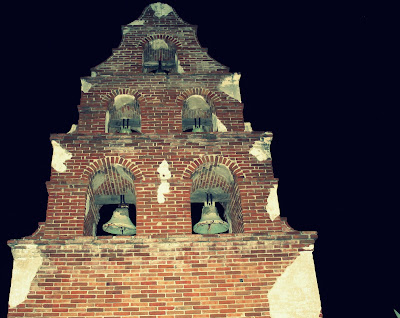When Mission San Miguel was founded on July 25, 1797 just
north of Paso Robles, the founding fathers could never have imagined the terror
that would occur at this sacred site just 49 years later. The scene of a horrific murder, many people
believe this mission is haunted. We may not know about ghosts, but here’s what
we do know about that cold December night. The original temporary church built
in 1797 burned in 1806, and a stone foundation church was completed in 1821.
After Mexico fought against and won their independence from Spain, the Mission
system began to collapse and by 1834 the Mission had become secularized. On
July 4, 1846, Petronillo Rios and his business partner William Reed purchased the floundering mission for a few hundred
dollars, operating it as a lodging and trading post and Reed and his family lived
there. Reed, usually wearing a blue peacoat, required that guests pay in gold, and
he bragged that he’d amassed a small fortune, hiding it somewhere at the
mission. Remember that California was not part of the U.S. at this time and any
currencies from Mexico, the U.S., and even money from Spain were probably
considered worthless. Gold was what mattered.
On the afternoon of December 4th, 1848, six men arrived at
Mission San Miguel. Pete Raymond, Joseph Lynch, Peter Remer, Peter Quin, and Sam
Bernard, accompanied by someone only known as “John,” an Indian from Soledad. They
stayed that night but left the next morning heading south to San Marcos Creek
just a few miles down the road but then they returned to the mission and spent
the rest of the day and part of the evening there on December 5th. It
was during these early evening hours that this gang of cold-hearted men murdered everyone at the Mission
including William Reed and his wife, Maria who was expecting a baby, and their
4-year old son. Also killed was Josefa Olivera, Maria’s mid-wife, and 3 other
children; 11 people in total. The men had been warming themselves near a fire
when Bernard offered to go outside to get firewood. He returned with an axe
hidden in his armload of wood and struck Reed several times while John the
Indian stabbed him with a knife. Sam Bernard and the others stalked and killed
the women and children, then took the bodies to the carpenter's shop. When
their blood-drenched bodies were were found they were still wearing daytime clothes.
Based on the interrogations of Joseph Lynch, Peter Quin and
of Peter Remer, this is what happened that cold December night. After the ruthless
murders they drank wine stealing any valuables they could find, which wasn’t
much, ransacking the place in search of Reed’s gold – but they never found any.
They left the mission that evening and spent the rest of the night south of
present-day Templeton, and spent the next night south of Mission San Luis
Obispo, but by this time a posse had been
formed and was tracking them. What they didn’t know was that on the very
night of the killings, a man named James Beckwourth was carrying mail from
Nipomo to Monterey when he stopped at the mission and discovered the bodies.
Shocked, he rode on to Monterey and informed the military governor of the
murders. The gang left San Luis Obispo and traveled down to the Los Alamos area
and obtained, we presume, fresh horses at a ranch. They rode through Santa
Barbara stopping at Rancho Ortega, at present day Summerland, where the posse
caught up with them, but this was not to be a bloodless arrest. Sam Bernard was
mortally wounded. Pete Raymond jumped into the surf attempting to escape, and
was drowned. Peter Quin was wounded and captured having killed a member of the
posse; Joseph Lynch and Peter Remer were also captured, and later confessed to
their parts in the murders. John the Indian had peeled off from the group
around San Luis Obispo and was never found.
 |
| The chapel interior |
Reed’s partner Petronilo Rios, helped bury Reed and the
other victims in the cemetery of Mission San Miguel, “just outside the rear
door of the sacristy; a little to the southwest and near the old first church
wall,” according to one account. All 11 people were buried in one mass grave and it must have been a
disturbing sight seeing the bodies of the children.
Lieutenant Edward O. C. Ord (Fort Ord in Monterey was named
after him) from Monterey and nine soldiers were dispatched to Santa Barbara to
act as a firing squad.
According to accounts Joseph Lynch, Peter Remer and Peter
Quin were executed by firing squad in
Santa Barbara on December 28, 1848, near the corner of De la Guerra and Chapala
Streets. Reports said they were buried in the cemetery of Mission Santa Barbara,
but that seems highly unlikely that they would have been buried there
considering the murderous acts they had committed at Mission San Miguel. At any
rate, following the murders Mission San Miguel converted rooms into a hotel,
saloon, and retail shops. Over the years many people have claimed they have
seen the ghosts of William Reed, wearing his peacoat and a lady in a white dress around the mission grounds.
Some swear they
have heard muffled screams coming
from near the chapel, and images of the young boys who were killed that night. Are
ghosts real? And do the tortured souls of innocent victims attempt to make
contact with the present world? Is the gold still there, or was it ever there?
Does William Reed and his wife, Maria call out from their graves? That’s for
you to decide. Perhaps when you visit Mission San Miguel you might find the
answers.
Watch my “2 Minute Travel” video shot at Mission San Miguel
at midnight: GHOSTS OF THE COAST










